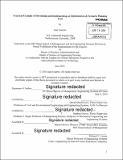| dc.contributor.advisor | David Simchi-Levi and Stephen Graves. | en_US |
| dc.contributor.author | Guertin, Jane | en_US |
| dc.contributor.other | Leaders for Global Operations Program. | en_US |
| dc.date.accessioned | 2014-10-08T15:28:57Z | |
| dc.date.available | 2014-10-08T15:28:57Z | |
| dc.date.copyright | 2014 | en_US |
| dc.date.issued | 2014 | en_US |
| dc.identifier.uri | http://hdl.handle.net/1721.1/90784 | |
| dc.description | Thesis: M.B.A., Massachusetts Institute of Technology, Sloan School of Management, 2014. In conjunction with the Leaders for Global Operations Program at MIT. | en_US |
| dc.description | Thesis: S.M., Massachusetts Institute of Technology, Engineering Systems Division, 2014. In conjunction with the Leaders for Global Operations Program at MIT. | en_US |
| dc.description | Cataloged from PDF version of thesis. | en_US |
| dc.description | Includes bibliographical references (pages 64-65). | en_US |
| dc.description.abstract | There is significant complexity facing the Global Footwear Planning team when sourcing production, especially for sandals. The challenges include increasing manufacturing costs coupled with a changing tariff landscape and a high degree of complexity to produce the products. This thesis provides a practical example of the use of an optimization model for determining where to produce, and how much to produce, of each product, including the ability to perform strategic what-if scenarios. The model is based on minimizing the total landed cost for each product. This includes the manufacturing, transportation, holding, and tariff costs. The initial pilot model results suggested a 4-11% decrease in spending for a given year. This model provides the starting point for additional work to improve optimization in the sourcing group. The implementation of this model reinforces the notion of how much support is needed in an organization to change processes and implement new software models. Future work should include the addition of simulation, as the data are highly variable at the decision point. | en_US |
| dc.description.statementofresponsibility | by Jane Guertin. | en_US |
| dc.format.extent | 65 pages | en_US |
| dc.language.iso | eng | en_US |
| dc.publisher | Massachusetts Institute of Technology | en_US |
| dc.rights | M.I.T. theses are protected by copyright. They may be viewed from this source for any purpose, but reproduction or distribution in any format is prohibited without written permission. See provided URL for inquiries about permission. | en_US |
| dc.rights.uri | http://dspace.mit.edu/handle/1721.1/7582 | en_US |
| dc.subject | Sloan School of Management. | en_US |
| dc.subject | Engineering Systems Division. | en_US |
| dc.subject | Leaders for Global Operations Program. | en_US |
| dc.title | Practical example of developing and implementing an optimization & scenario planning tool | en_US |
| dc.type | Thesis | en_US |
| dc.description.degree | M.B.A. | en_US |
| dc.description.degree | S.M. | en_US |
| dc.contributor.department | Leaders for Global Operations Program at MIT | en_US |
| dc.contributor.department | Massachusetts Institute of Technology. Engineering Systems Division | |
| dc.contributor.department | Sloan School of Management | |
| dc.identifier.oclc | 891569532 | en_US |
